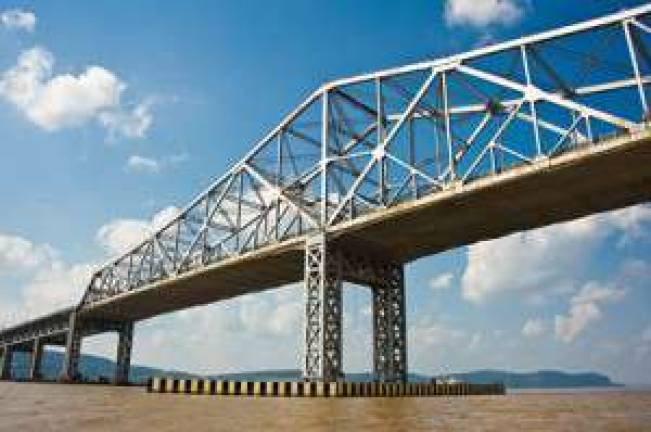Cuomo Calls Task Force to Cut Cost of Tappan Zee Bridge

Our Mike Bocamazo reports: Gov. Andrew Cuomo today said that the Thruway Authority needs to take further steps to try to reduce the cost ? and size of proposed toll hikes ? for the planned replacement to the Tappan Zee bridge, which is estimated to cost as much as $5.2 billion.
The preliminary schedule would set the toll for a new bridge at $14, while repairs on the existing bridge would raise the tolls to $12 by 2017, according to state projections. "I want to put together a task force, I want to get our federal partners involved, and find ways to reduce the preliminary toll schedule that they've put out as estimates," the governor said this morning on Fred Dicker's radio show. "Maybe they buy the bridge cheaper as they say. Maybe there's ways to negotiate a better deal on the bridge, make it less expensive. Maybe there are ways to find federal funding." Cuomo, who also released a letter today to the Thruway Authority regarding the cost of the Tappan Zee Bridge, stressed the importance of the human aspect of the project. "I'd like to have a blue ribbon panel make the selection [of the design]," he said. "Not just technical engineering panels and cost panels, [?] because this bridge touches so many aspects of life in that landscape, in that region, over theHudson River." In his letter to the Thruway, Cuomo again emphasized that the bridge will have "mass transit capability," repeating the administration's answer to transit advocates who have been pushing to immediately add more mass transit. The current plans call for dedicated bus lanes on the new bridge part of the day, but not along the entire corridor as some transit advocates want. Cuomo's letter to the Thruway Authority regarding the Tappan Zee Bridge is below: Dear Chairman Milstein and Director Madison: I have reviewed the recently released Final Environmental Impact Statement (FEIS). I applaud the hundreds of citizens who have attended public meetings in recent weeks to learn more about the FEIS and the thousands more who took the time to add their comments in writing. I am pleased by a number of elements of the FEIS and the Thruways' design specifications: ?The inclusion of mass transit capability on the bridge. As reflected in the FEIS and the Thruway's design specifications, the bridge will be able to accommodate virtually any kind of future mass transit configuration, whether commuter rail, or a Bus Rapid Transit system in the Westchester-Rockland corridor. The bridge will be able to accommodate a dedicated bus lane from day one. There can be no question that the future of transportation in the region is mass transit, and our immediate need to replace the Tappan Zee with a transit-capable bridge must be the first step in the expansion of regional transit. ?It will cost nearly the same to repair the current bridge as it would to build the new bridge. Yet only repairing the current bridge does not solve any of the problems motorists and residents face today: no shoulders, no emergency access, congestion and backed up traffic with air and noise pollution ? and repairing closes the door to any kind of transit on the bridge. By contrast, a new bridge brings not only transit capacity, but expanded lanes to reduce congestion, and accommodate emergency vehicles, breakdown lanes, and pedestrian and bike access ? and a 100 year life before major maintenance. At a cost in the same range as repairing the bridge. · State of the art environmental mitigation measures ensure that the natural environment will be protected. The steps that will be used include "bubble curtains" to protect fish from the noise of pile driving, using vibration instead of pile driving whenever possible to set piles, and limits on dredging and other protection measures that will protect wildlife in the unique Hudson River environment. · Protecting local communities from construction impact By limiting pile-driving to certain hours, installing air and noise monitors in impacted areas, and bringing the vast majority of materials to the bridge by river barge and avoiding local roads, the FEIS helps ensure that communities will be inconvenienced will to the minimum possible These are all good steps, and since the publication of the FEIS, local officials throughout the region have come together in an unprecedented bipartisan fashion to express their support for this bridge replacement project. They agree that spending billions to simply repair the current bridge won't fix the accident rate, the congestion, or the air and noise pollution that Westchester and Rockland residents live with now. They recognize that the existing Tappan Zee bridge is inadequate to the transportation and economic needs of the lower Hudson Valley and New York State and a new transit capable bridge as proposed in the FEIS is the only option. I agree, but I do have recommendations to the Thruway Authority of ways to do even better in certain areas. To read the full article at City & State click here.